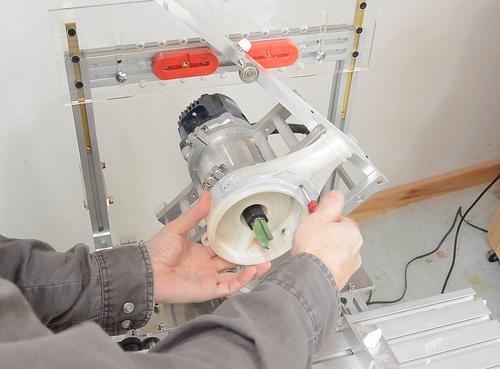 A weaknesses of the pantorouter is dust collection.
When cutting tenons, the pantorouter throws chips in
every direction.
A weaknesses of the pantorouter is dust collection.
When cutting tenons, the pantorouter throws chips in
every direction.
 A weaknesses of the pantorouter is dust collection.
When cutting tenons, the pantorouter throws chips in
every direction.
A weaknesses of the pantorouter is dust collection.
When cutting tenons, the pantorouter throws chips in
every direction.
Personally, I considered dust collection for the pantorouter a lost cause, but this didn't stop Kuldeep from experimenting with developing a dust collection hood. He sent me a 3D printed prototype to try out.
The hood attaches to the front of the pantorouter.
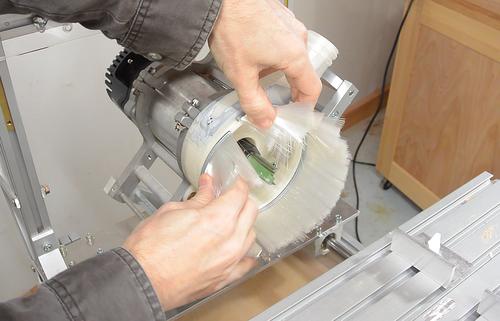
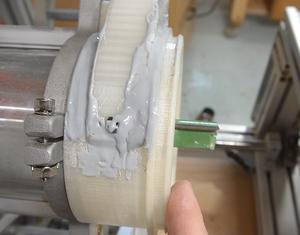 The hood deflects all the exhaust cooling air from the router
towards the bottom. It also has a ring of brush bristles that snaps
onto the front of it to help direct the chips into the hood.
The hood deflects all the exhaust cooling air from the router
towards the bottom. It also has a ring of brush bristles that snaps
onto the front of it to help direct the chips into the hood.
A limiting aspect of this hood, at least when used with my cheap MasterCraft router, is that it comes forward further than the router collet, which limits how deep I can cut with it.
I also don't like the idea of having my view obstructed by the brush around the dust collection hood.
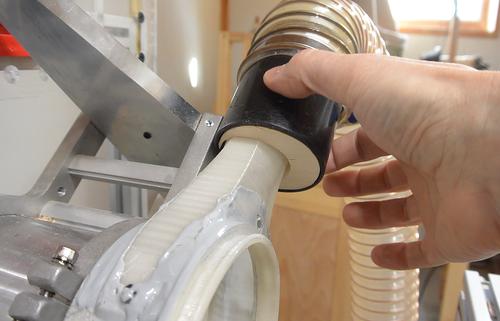 The hood has a connection for a 40 mm dust collector hose, the same
size as the Festool vacuum cleaner. I don't have a Festool, and
I'm not a big fan of shopvacs, so
I made a wooden plug to fit in the end of my 2.5" dust collector hose
so I could hook my small dust
collector to it.
The hood has a connection for a 40 mm dust collector hose, the same
size as the Festool vacuum cleaner. I don't have a Festool, and
I'm not a big fan of shopvacs, so
I made a wooden plug to fit in the end of my 2.5" dust collector hose
so I could hook my small dust
collector to it.
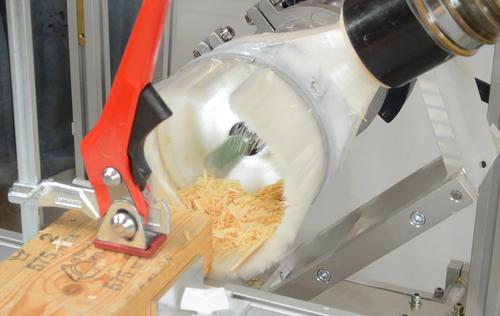 Surprisingly, the dust collection hood worked, but there was always
a pile of chips left in the bottom of the hood.
Surprisingly, the dust collection hood worked, but there was always
a pile of chips left in the bottom of the hood.
So I thought I'd experiment with making a wooden version where the chips are pulled out more towards the bottom.
A seemigly obvious solution would be to have the whole hose thing coming off the bottom, but there's no place on the bottom that the hose could come off without hitting the base of the pantorouter or the table at some point as the router moves through its full range of motion.
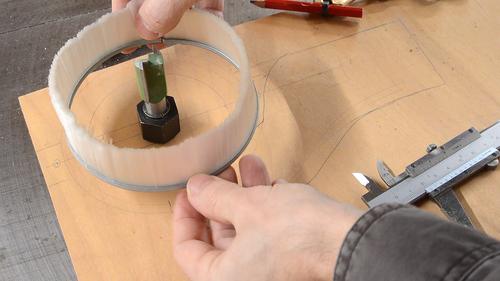
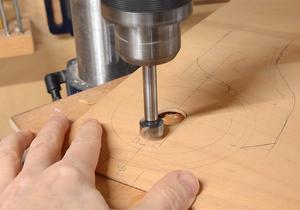 I drew up a layout on a piece of plywood, here showing how it
will arrange with the router bit and the brush. The air path
is curved to pull the chips out from the bottom.
I drew up a layout on a piece of plywood, here showing how it
will arrange with the router bit and the brush. The air path
is curved to pull the chips out from the bottom.
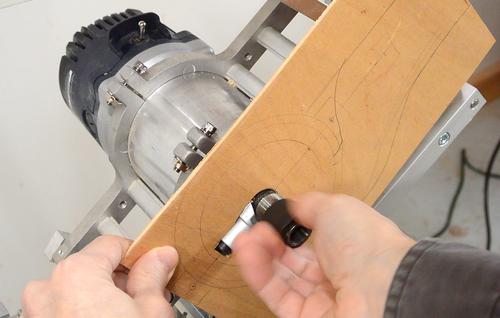
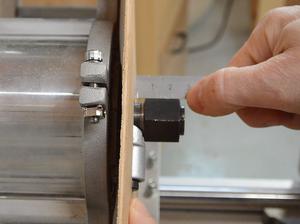 After cutting the hole for the collet and collet lock, checking
the fit on the actual pantorouter.
After cutting the hole for the collet and collet lock, checking
the fit on the actual pantorouter.
I decided to make this one less thick so it wouldn't limit the depth of cut as much.
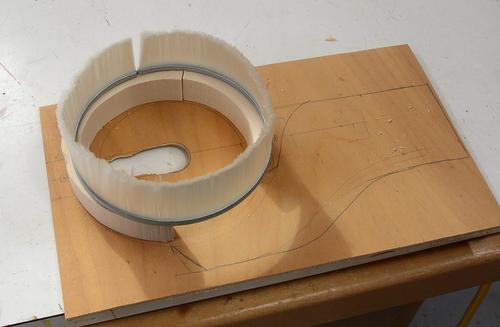
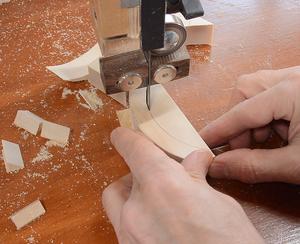 I cut out some curved pieces of wood to form the shape of it.
I cut out some curved pieces of wood to form the shape of it.
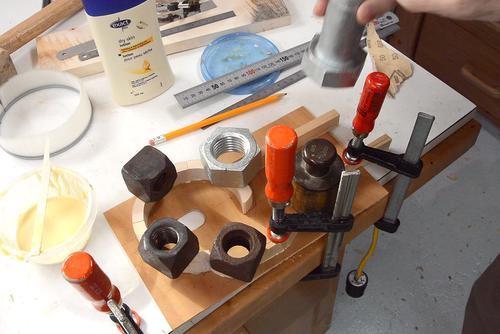 Gluing it on the plywood, just weighing the pieces down for
clamping.
Gluing it on the plywood, just weighing the pieces down for
clamping.
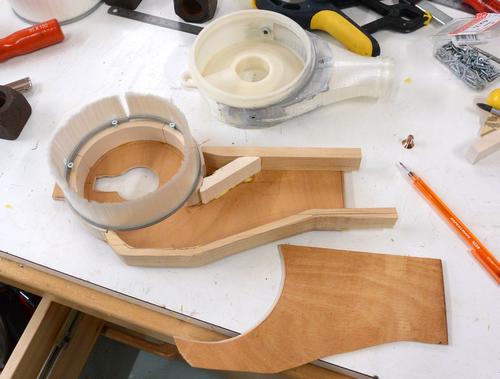 I then cut around it with the bandsaw and also made a cover
for the front.
I then cut around it with the bandsaw and also made a cover
for the front.
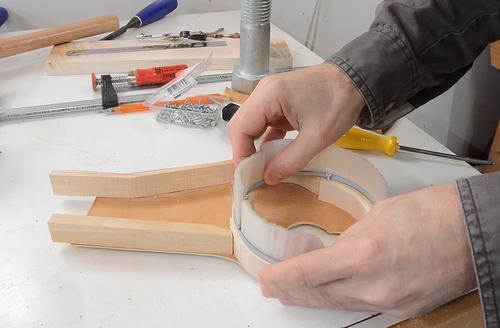
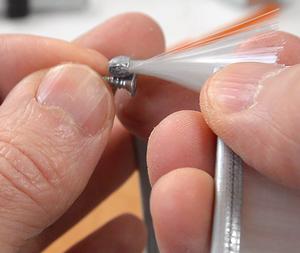 I couldn't easily make a ledge for the brush to clip on to so
I used several #4 countersink screws to hook the brush instead.
I couldn't easily make a ledge for the brush to clip on to so
I used several #4 countersink screws to hook the brush instead.
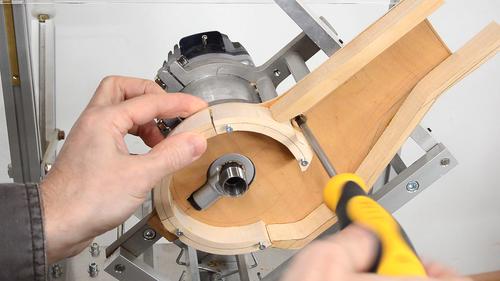 Testing the fit on the pantorouter again.
Testing the fit on the pantorouter again.
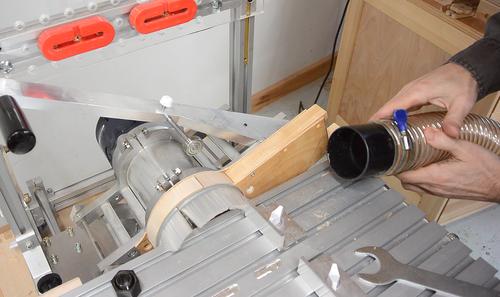 Initially, I had wanted to angle the hose downward a bit, then
I realized if I did that, the hose would hit the table. So
I had to point the hose straight out (upward) to clear
the table.
Initially, I had wanted to angle the hose downward a bit, then
I realized if I did that, the hose would hit the table. So
I had to point the hose straight out (upward) to clear
the table.
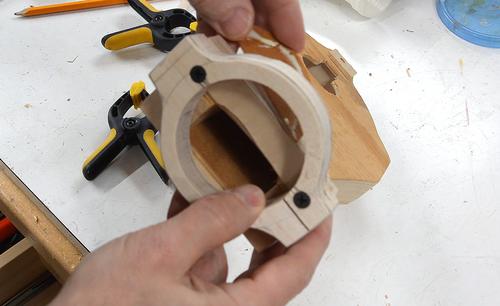 The hose has to mount offset to help clear the table.
The hose has to mount offset to help clear the table.
This leaves an opening in the back, which I'm closing by gluing a piece of plywood to it.
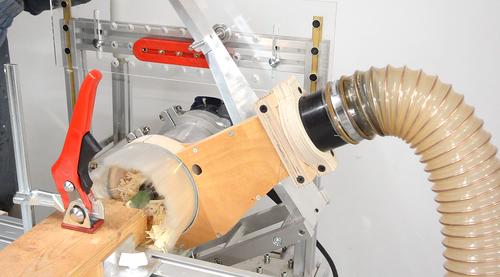
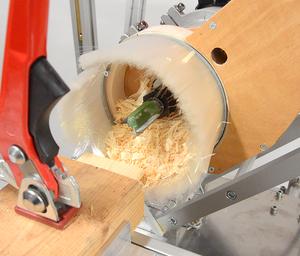 Trying it out. With the workpiece I tried it with, the hood ended
up clogging up. Cutting a big tenon in the end of a 2x4 isn't the
easiest to deal with (the chips are large and long), but given how
fast it clogged up, I wasn't optimistic about this hood
being usable for anything.
Trying it out. With the workpiece I tried it with, the hood ended
up clogging up. Cutting a big tenon in the end of a 2x4 isn't the
easiest to deal with (the chips are large and long), but given how
fast it clogged up, I wasn't optimistic about this hood
being usable for anything.
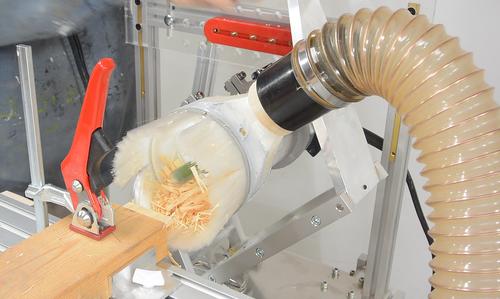
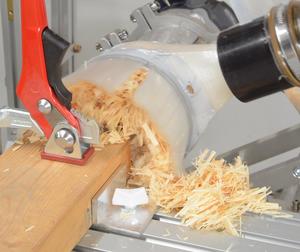 Next I tried the same test with the hood that Kuldeep send to me.
It worked better than the one I built, but it too eventually clogged
up after cutting several tenons.
Next I tried the same test with the hood that Kuldeep send to me.
It worked better than the one I built, but it too eventually clogged
up after cutting several tenons.
Many have suggested
on YouTube that the hose connection should be on the bottom to suck
up the chips better. But with the
range of motion of the router, there is no place on the bottom
where the hose wouldn't hit the table or the base at some point.
Another suggestion was to just have the brush on top but not the
bottom and let the chips fall down. But that would do little
to capture airborne dust.
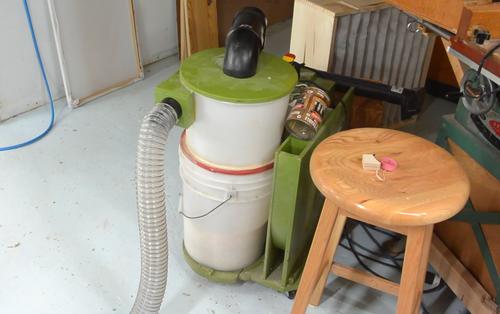 Part of the problem may be my
homemade dust collector. This dust collector can produce a
static pressure the same as 350 mm of water. That is quite a lot
for a small dust collector, but a typical shopvac can produce about
1500 mm of suction (though at a relatively low airflow). Still,
having more than four times the suction would probably clear most clogs.
Part of the problem may be my
homemade dust collector. This dust collector can produce a
static pressure the same as 350 mm of water. That is quite a lot
for a small dust collector, but a typical shopvac can produce about
1500 mm of suction (though at a relatively low airflow). Still,
having more than four times the suction would probably clear most clogs.
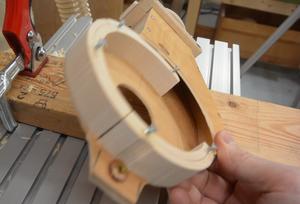 At any rate, my "improved design" turned out to work much worse than
Kuldeep's. Granted, Kuldeep's often leaves some chips in the bottom of the
hood, but while cutting, whatever is in the hood gets stirred up quite
a lot, and nearly all the chips got sucked up into the hose eventually.
At any rate, my "improved design" turned out to work much worse than
Kuldeep's. Granted, Kuldeep's often leaves some chips in the bottom of the
hood, but while cutting, whatever is in the hood gets stirred up quite
a lot, and nearly all the chips got sucked up into the hose eventually.
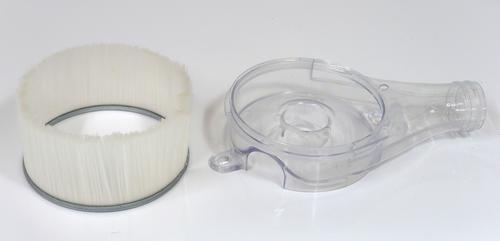 The above tests were done in March of 2016.
The above tests were done in March of 2016.
Kuldeep continued to refine the design, and in July 2016 he sent me a final, injection molded dust collection hood. This one was a lower profile than the previous one so it would restrict the depth of cut less. Based on my experience with the prototype, I was skeptical. But testing it surprised me.
This was in 2016. In 2021, Mac Sheldon came up with a new dust hood design that flips open so that it can be used with routers that require two collet wrenches. I fitted that to my wooden pantorouter